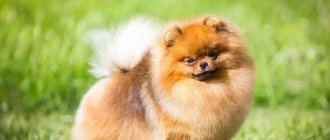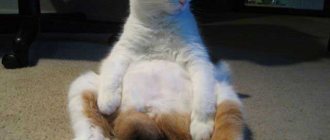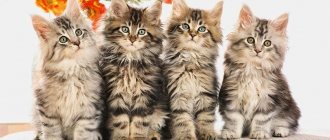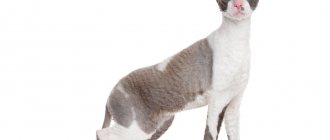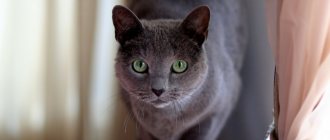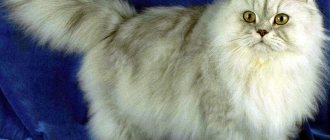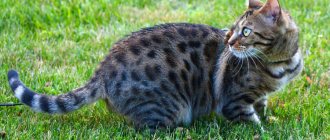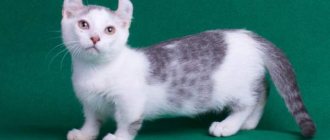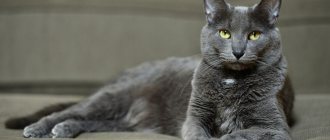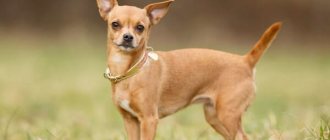Siberian cat(1) The Siberian cat breed is conventionally considered an aboriginal cat of northern Russia, because there is no exact data on the origin of this incredibly fur-bearing animal. For a long time, all the fluffy and strong cats in the region were considered “Siberian” and the breed did not have a standard. It was only in 1996 that the Siberian cat received recognition as an independent breed in TICA.
The long-lived breed often grows to an average weight of 5-6 kilograms, but there are males weighing 10-12 kilograms. Gorgeous fluffy fur with a thick undercoat allows you to live not only in an apartment, but also to become a good mouse catcher in a private home. The breed's hunting instincts are well developed and have not become dulled at all. The nature of the breed is calm, long playful and mischievous maturation (up to 2-3 years) is then compensated by devotion and friendliness to the whole family. Buying a Siberian fluffy kitten is not difficult - a lot of private advertisements and professional nurseries provide a wide choice of prices and quality of kittens.
Ragdoll(2)
Thanks to the enterprising breeder who developed the breed, the history of the origin of the Ragdoll is shrouded in mysticism and full of stories whose authenticity is difficult to believe.
Deception, intrigue and the desire to cash in on a beautiful legend for a long time prevented the increasingly popular breed from obtaining not only a standard, but even exhibition status until 2000 was unattainable. But in defense of the breed itself, it should be noted that the cat turned out to be very beautiful. Expressive blue eyes and evenly filled fluffy fur make the animal look like something man-made, as if it were a mechanical toy in the shape of a cat that the master worked on for many months.
A distinctive feature of the breed is, due to its physical characteristics, to go limp when relaxed to the consistency of dough. This happens due to weak muscle tone.
By nature, the breed is very gentle and affectionate towards its family. Being alone, even for a few hours, is a burden for Ragdolls.
Ragamuffin
This breed is considered very young; it was bred in America in the late 60s, thanks to the crossing of an ordinary yard cat with an elite breed. The breed gained its independence only in the 2000s.
Such cats take five years to form; before that, such Ragamuffin cats are in the formative period. The animal's chest has the shape of a wide rectangle, while the neck is short, which makes such a cat look very fluffy, since there are no visible transitions from the body to the neck.
Ragamuffin cats almost never have a white color, and there is no particular pattern in the color style - it can be either monochromatic or mixed. The wool itself is medium in length and soft to the touch.
The head is wide, shaped like an oval, the eyes can be either green or golden. There are cats with eyes of different colors. The ears are set wide apart and the tips are rounded. The body is long and strong, the tail is also long.
If you need to choose a kind, non-aggressive pet for your family, then Ragamuffin cats fit this description. They are neither aggressors nor hunters; cats get along calmly with everyone, including children. Free walks are not encouraged, as animals feel better at home, safe, although some types of Ragamuffin cats can allow themselves to be leashed. There are no problems getting along with other animals. They jump on your hands willingly.
How to care? Here again we need to talk about the need for constant combing of the fur - this is the fate of all owners of long-haired cats. You should immediately, as soon as the animal appears in the house, accustom yourself and the animal to the fact that you will have to do combing every week. Let the animal get used to the tool and smell it. The comb should be metal and the teeth should be long.
We must not forget about the claws, since this breed is not intended, in most cases, for walking, during which the claws themselves grind off on the asphalt. For Ragamuffin cats, you need to set aside time, about once a month, for the trimming process. It would be useful to install a special post or log in the house, on which the cat will grind its claws. Otherwise, furniture will act as this device, which no one wants.
We are lucky that such cats rarely need to be bathed, only once a year, as they do it with great reluctance. You need to bathe them in warm water using shampoo. Regarding nutrition, the following must be said - the owner himself chooses whether to give the cat elite food or natural products. The cost reaches about 50 thousand.
Norwegian Forest Cat(3)
The Angora cat found its way into the Scandinavian forests in the 16th century, and in order to survive, the breed began to grow an even thicker undercoat. Thus, over time, a fluffy cat breed was formed, distinguished by a graceful long body and a spreading long-haired tail.
Since 1977, the Norwegian cat has had an exhibition standard and successfully competes in Europe with Maine Coons in popularity in home keeping.
Long life in forests with a harsh climate left a corresponding imprint on the character of the breed. A playful kitten grows into an independent and self-sufficient animal that would rather go for a walk with you on a harness and explore the territory with interest than seek affection, games and attention at home.
Ragdoll
The name of the breed translates as “rag doll”. The ancestors were a white long-haired cat and a Burmese cat. Artificially selected, they are absolutely devoid of the instinct of self-preservation and require special care and a lot of attention. They are calm and pliable, thanks to their specific muscle tone, and sometimes seem like toys.
This fluffy treasure has soft, thick fur, a thick bushy tail and a “collar”, the animal sheds little. But he has a thirst for research and an easy-going character.
Maine Coon(4)
An indigenous breed of large fluffy cats in America, which appeared as a result of crossing the cats of the first settlers with local cats. In terms of popularity, this formidable-looking breed breaks all records. Everyone who decides to get a large cat declares that this is an excellent choice that they would repeat without hesitation.
Female Maine Coons are much smaller than males. The difference is about half the weight of the cats. External severity conceals a gentle character. Maine Coons take a long time to grow up, but they always treat their owners with special tenderness, lovingly love their family and grieve when they are apart.
The ability of fluffy fur to keep its shape during grooming makes it possible to make life easier for cats during hot periods and give a particularly funny look to a domestic lion.
I and II categories according to FIFe
Most of the breeds recorded in this association are recognized by other large communities. Documents of the World Felinological Club have.
American Longhair Curl
A large cat with characteristic upturned ears.
Read more in the article about the American Curl.
Balinese cat
A breed offshoot from Siamese ancestors. They have semi-long, rather hard fur, and are most often color-point in color. The animals have a friendly disposition and are excellent playmates for children.
More about Balinese is written here.
British
Noble cats with thick plush fur.
Read articles about British shorthair and longhair cats.
Himalayan cat
Phenotypically and in character, they are similar to their Persian relatives, but have clear blue eyes and a contrasting colorpoint color.
Read more about this cat here.
Maine Coon
Not only fluffy, but also a large breed. Despite their wild and predatory appearance, they are very affectionate and tame.
Read a lot of interesting information about the origin, character of Maine Coons, as well as their care here.
Persian breed
Record holders for fur length. Sometimes it can reach twenty centimeters in length.
Much has been written about these mega-furry creatures here.
Did you know that this fluffiest cat in the world is actually prone to aggression? Read about this, as well as about other most evil cat breeds.
Burmese breed
Outwardly, it is also similar to the Siamese, but differs in white socks and a more rounded head shape.
Read a lot of interesting information about this breed in the article about Burmese.
Siberian cat
An ancient variety with a long history and a characteristic exterior inherited from their northern forest ancestors.
Read about these amazing forest cats in the article here.
Neva Masquerade
They were bred from Siberians, and differ from them in their blue eyes and color-point color.
Read more in the article about the Neva Masquerade.
Turkish Angora
Noble animals with unusual dense soft fur.
About this extraordinary snow-white cat
Persian cat(5)
It is difficult to find a calmer and more famous breed of fluffy cats. The upturned nose and incomparable weightless fur coat are difficult to confuse with anything else.
The origin of the animal’s special fur casts doubt on some theories of the origin of the breed, because although the cat came to Europe from Persia, it also could not have appeared in Persia on its own - the undercoat was too thick for a hot climate. In any case, the breed has a very old standard by cat standards from 1887 and is the base breed for breeding work for many younger cat breeds.
Under a thick fur coat, the Persian has a strong body; if the breeders did not make mistakes in breeding related crosses, then the cat’s health is excellent. The character fully matches the appearance. A domestic Persian cat is an interior decoration and a subject of constant care for the owner, because to prevent the flying thick fur from turning first into tangles and then into felt boots, the pet needs to be scratched at least once every 2 days, and preferably every day.
Features of care
Fluffy cats are very cute and beautiful. However, when planning to have such a pet, owners should know the basic rules for caring for it:
- Combing . Long and fluffy fur requires special attention. Such cats should be combed daily with a special comb to avoid the formation of tangles, improve the condition of the coat, and speed up the shedding process.
- Hygiene . Proper care of cats of fluffy breeds involves regular hygiene procedures. Pets should clean their eyes and ears daily using a cotton swab. When cleaning the ear canal, a cotton swab or swab should be pre-treated in vegetable oil. A solution of boric acid is also suitable for these purposes.
- Haircuts . Periodic visits to the cat groomer and regular haircuts, which are recommended to be done every few months (at least once every six months), can improve the condition of the pet’s fur and appearance.
- Bathing . Fluffy cats need bathing and water treatments, which are necessary even if the animal does not leave the house or go outside. The fact is that thick wool and undercoat, one way or another, accumulate dust. Bathing (read how to wash a cat) is recommended to be done once every 1-2 months, using for this purpose a special cat shampoo, which can be purchased at veterinary pharmacies and specialized stores. Often, owners of long-haired pets are faced with the problem of water intolerance in their cats. In this case, you should buy a special dry shampoo and clean your pet’s fur with it.
- Nutritional Features. Cats with fluffy, long coats often swallow hair when eating food, which can lead to disturbances in the functioning of the gastrointestinal tract, problems with appetite, nausea and vomiting. This can be avoided by using special food that helps remove hair from the animal’s body. Also, good results are obtained by adding fresh grass to your pet’s diet, which you can grow yourself at home on the windowsill.
In all other respects, caring for furry cats is almost identical to caring for other pets. Love, attention, maintaining a water regime, vaccinations and regular visits to the veterinarian - that’s all that is necessary for a cat’s vigor, health and longevity.
Cymric (6)
A fluffy breed of cats from Great Britain, which still does not have universal recognition as an independent breed, but this does not at all prevent it from gaining popularity. Cymrics appeared as a result of the Manx mutation, which was noticed in Canada and began to be cultivated as a full-fledged feature of the new breed, and not culled as a violation of the old one.
In fact, the Cymric's body is exactly the same as that of the Manx, the only difference really being the length of the coat.
In everyday life, the breed is very musical; the cat comments on all its close communication with its owner by purring and meowing. When interacting with dogs and other cats, the breed is non-conflicting; it is easier for a Cymric to retreat than to defend territory. Owners note that the breed gets along with children, can play with babies and is very patient with pranks as long as they do not cause pain.
Balinese cat
Balinese have a dense, medium-length coat, which may visually appear shorter than it actually is. Their fluffiest tail is their large, luxurious tail, which is why they make it into our top. The length of the hairline here reaches 7 centimeters. The animal requires proper care, as it requires frequent brushing. Without it, the undercoat gets tangled easily. Another feature of the species is congenital strabismus.
The breed was named after the Balinese dancers, because these beauties are not inferior to them in grace, elegance and flexibility.
The color shows the influence of Siamese ancestors, the eyes are sky blue.
British Longhair (7)
We are all accustomed to visualizing British cats as plush, short-haired, plump cats, but the British breed can even be very long-haired without losing the density of the undercoat. Lowlanders appeared as a result of unsuccessful crossings with Persian cats of classic British shorthairs. The recessive gene for long hair became dominant and instead of expanding the palette, the British breed received a “defect in production.” Now the breed in many authoritative communities of felinologists has the status of new and unsettled, although there are more and more breeders in each country.
The semi-long coat is the most important and only distinguishing feature of the breed; otherwise, the longhaired British are no different from their ancestors with a plush coat. Even the character traits of the breeds are similar. You will never hear loud whims from a furry Briton, and in everyday life the cat observes more than participates in family affairs. It tolerates separation well, but after a couple of days it begins to get bored, so choose nannies familiar to the cat for the period of vacations and business trips, so that the animal does not fall into melancholy and does not lose contact with the owner upon return due to resentment.
Buying a kitten
There is probably no more charming creature in the world than a small fluffy kitten - a gentle and touching bundle of soft, warm fur. However, all children tend to grow up quite quickly, and problems that at first might seem completely insignificant to you grow with them. A few tips to help you make the right choice:
- Do not be led by your emotions - do not buy a kitten spontaneously, succumbing to a completely understandable feeling of tenderness at the wonderful baby - you are not buying a soft toy, but a living creature that has its own character and its own needs.
The little fluffy ball will grow up soon, so it’s important to base your choice of a kitten on more than just cuteness
- You will need to take care of the kitten, educate, adapt, tolerate its pranks - it is quite possible that some problems associated with the new family member will not suit your family - be sure to consult with them and make only a collective decision.
- Try to learn as much as possible about the breed you like, prepare for the arrival of a kitten in your home, both theoretically and practically - purchase in advance everything you need for feeding, rest, hygiene and leisure for your baby.
How to choose
You need to decide in a timely manner not only about the breed, but also about the purpose of acquisition. Do you want a boy or a girl? Pet or show-class animal? The criteria for choosing a little furry will largely depend on your ambitions and financial capabilities.
But the main selection criterion always remains the same - you need to purchase a healthy animal with good heredity. It is clear that no one can give one hundred percent guarantees on these issues in advance, but buying a baby not on the market, but in a professional breeding nursery, still significantly reduces many risks. In addition, a responsible breeder will forever remain your friend and first mate.
Don't try to buy a kitten that is too small; The optimal age for moving him to a new home is 2.5–3 months, when the necessary vaccinations have already been completed and independent living skills have been acquired. If possible, look at the conditions in which your baby grew up, observe the habits and habits of his parents, brothers and sisters.
After two months, vaccinated kittens can move to a new place
The baby will get used to the new place quite quickly, and from the second or third day he will need to be taught the rules of life that you consider necessary. The sooner he learns them, the more positive and pleasant moments will appear in your life together.
Find mutual understanding with your baby as soon as possible
Video: fluffy kittens - all good
Turkish Van(8)
Despite the name, the homeland of these fluffy white cats with markings on the tops of their heads is Armenia, and specifically Lake Van. It is precisely because of their long-term residence next to an open, calm body of water that modern representatives of the breed are very fond of water treatments and fish, to which other cats, let’s be honest, are indifferent.
Now the breed is considered an official national treasure of Turkey, but only individuals with different eyes are valued.
A show van is only considered if it has ring markings on its tail and no undercoat. The breed's fluffy coat holds volume due to its lightness, rather than the supporting down of the underside. Also, the cat should not be completely white - this is a critical violation for the admission of an individual to exhibitions.
Furry pet care
Jungle cat: options for breed names and animal sizes
Caring for long-haired felines is more difficult than caring for short-haired ones. First of all, this is grooming
Grooming
The main procedure for keeping the fur in order is combing. This procedure is carried out using slicker brushes. Their metal teeth, arranged in several rows, easily remove lost hair. Comb out with gentle movements. Strong pressure and sharp jerks can damage the animal's skin.
Pukhoderka
Fine-toothed combs are also good for combing; they remove both fluff and guard hairs. There are special mittens, but they are inferior in effectiveness to slicker brushes and fine combs. It's more of a massage that your pet will respond positively to.
Combing mitt
You can please your pet with a special arch with bristles, which he will rub against with great pleasure.
Important! The arch cannot in any way replace the household labor of combing. Otherwise, the wool will become greasy and matted.
Arch-comb
Fluffy pets need to be washed, but not more than once every two months. There are now a lot of products on sale specifically for long-haired breeds. There is also cat balm for easy combing.
Caring for a fluffy kitten
Small fluffies that have not yet reached six months and have not shed their hair are combed not to remove lost fur, but to accustom them to brushes. Otherwise, then every combing will be a real hell. Small kittens should only be bathed if absolutely necessary.
In general, most furry cats have a calm, friendly character. But there are certain nuances in care associated with constant combing and washing the purrs. Therefore, a furry pet should be owned by someone who can devote enough time to the animal.
Nibelung (9)
Child of the Mists, which is how the name of the breed is literally translated, fully lives up to its name.
Flying fluffy fur covers the cat like a cloud, making it a ghostly creature with incredible green eyes. The breed was developed by chance as a result of the proximity of a Russian blue cat and a mongrel black cat. Further credit for the recognition of the breed and the formation of its breeding base belongs entirely to Cora Cobb, who enthusiastically appealed to all felinological associations in order to achieve recognition and a standard for the new breed. In 1997, Nibelungs finally received admission to exhibitions from TICA and gradually began to conquer more and more breeders in the USA, Canada and Europe.
The fluffy breed of cats the color of thick fog has something to conquer the common people. The special iris of the eyes of adult cats is always green. Even if kittens are born yellow-eyed, by 8 months the iris will still gradually turn green and acquire its final shade.
The breed is not easy to live with. When choosing its own person, the cat generally doesn’t care about all the other residents of the house. The cat will not enter into open conflict, but will obey and show tenderness only towards the chosen owner.
How many furry breeds are recognized by FIFe, WCF, CFA
There are three world organizations that assign official statuses to various newly developed cat breeds: FIFe, WCF and CFA. The number of breeds that have been registered by the relevant organizations is distributed as follows:
- The World Cat Organization (WCF) has legitimized about 70 breeds.
- There are 42 breeds registered by the International Cat Organization (FIFe).
- About 40 cat breeds have received official status from the Cat Fanciers Association (CFA).
Typically, the data is constantly updated as some breeds are repeated, although called differently, and some breeds are developed and added to the list from time to time.
Important point! The third part (31 breeds) of long-haired cats are distinguished by the fact that they have their own standard, therefore they have permission both for breeding work and for exhibition shows.
Napoleon(10)
The breed inherited short legs from munchkins and fluffy long hair from Persian cats, and the expression on its face seemed to be sculpted by a puppet master. Today, the breed of small fluffy cats does not have a standard, but among lovers of experimental and funny breeds it is quite popular.
The weight of the breed ranges between 2 and 3 kilograms, but, despite its miniature size, the body is quite strong. The large head does not have a prominent structure due to the abundant fluffy hair on the body, which in some representatives of the breed hides the paws almost entirely.
The experimental breed is very soft in character, despite its unstable appearance; the habits of Napoleon cats are generally similar. These are active pets who love to play and learn new commands. At the same time, the funny fluffy cat doesn’t mind basking peacefully on his owner’s lap.
Kimra cat
Cymriks are distinguished by a large massive body with a large head. The highlight is also the expressive large eyes from yellow-green to light blue.
Their thick, rabbit-like fur requires delicate care. By following it, you will get a beautiful, healthy pet of a wide variety of colors. There are individuals from white with colored splashes to tabby or calorpoint. A piquant feature is the absence of a tail in Cymrics. This is an artificially bred feature.
These friendly, calm cats get along easily with children, are peaceful and moderately active.
Himalayan cat(11)
The Persian breed has passed on its genes to many breeds, and the Himalayan cat breed is no exception, which was developed by crossing Persians and Siamese cats. The result was charming. A fluffy cat with a rich fur coat and a charming Siamese color captivates with its beauty.
Blue-eyed cats are very sensitive, they become attached to their owners and are very sad when separated. But if you work with the breed, you can get a cat who will know the commands and will be very enthusiastic about walking on a harness.
The breed has one problem - thick wool, prone to tangles. Daily brushing doesn't have to be tiresome if you decide to get this very fluffy cat.
Mekong Bobtail
This cat, according to legend, guarded young maidens in the ancient monasteries of Siam. They put their jewelry on the cat's tail. When there were too many of them, the animal's tail broke. That's why Bobtails have a short tail.
These cats have the character of a dog. They can carry objects in their teeth (and with pleasure), perform the “fetch” command, and walk on a leash. Also, these cats become attached only to the owner, and not to the house.
Mekongs are talkative, but do not like to show their emotions. The common feature with the Siamese cat is color.
Burmese cat(12)
The Burmese cat breed is very similar in appearance to the Himalayan cat, but upon closer examination the similarity becomes very, very superficial. First, you need to remember that Burmese cats are an indigenous breed of Myanmar. The breed came to Europe in 1917, but during the Second World War it lost its purebred gene pool. The breed was restored again with the help of Persians and Siamese cats, but as a result they managed to return to the old standard of appearance.
The breed's fur coat is fluffy, but does not have the same light hair of the Persians, which, if overlooked, always gets tangled. It is also especially important that the head is not heavy like a Persian, and the color points do not resemble Siamese standards.
But the most important breed difference between Burmese cats and Himalayan cats is the strict presence of white socks on their paws.
Ragamuffin
This very rare and valuable breed of long-haired cats was bred in California in the 1960s, and was officially recorded in 1994. Ragamuffins are the result of crossing phlegmatic Ragdolls with Persians and outbred long-haired cats.
Ragamuffins weigh about 8 kg and have a shaggy neck that resembles a collar. The eyes are almond-shaped, heterochromia occurs. The silky thick coat comes in a variety of colors: blue, tortoiseshell, grey, white, black, spotted. The pigmentation of the nose and paw pads often contrasts with the coat color.
Ragamuffins are very peaceful, calm, and devoted to their owner. Young individuals are quite active, love to play and can be trained. These cats easily find a common language with all family members. The main condition for keeping representatives of this breed is attention from the owner.
Neva Masquerade(13)
The color point breed got its fluffy coat structure from the Siberian breed. The cat was bred in Russia in the 1980s and by 1992 received standard and exhibition status, although not all felinological associations recognize the breed as an independent one.
Externally the breed is very attractive. The significant difference between male and female cats is their size - females grow up to 6 kilograms, and males up to 10. With this weight, the breed has a very strong body, inherited from its Siberian ancestors. Miniature proportions are considered a real defect and are rejected from breeding. The eyes must be medium or large in size with a blue, dark blue or blue-green iris.
In the family, cats are very sympathetic, they are always interested in all household chores. Among the games they like are those where there is an element of hunting; they are ready to learn a couple of commands. They treat strangers in the house with caution and very rarely come into their own, preferring to wait out the visit of guests in a secluded place.
2nd place. Ragdoll
These animals are believed to be native to the United States. The ancestor of modern representatives of one of the fluffiest cat breeds in the world is an ordinary domestic cat named Josephine, who accidentally ended up in a family of Californian breeders. As a result of mating with a Burmese male, she gave birth to unusual babies, the descendants of which were recognized as an independent variety, called Ragdoll.
These are quite large animals, weighing 8-12 kg. On a proportional wedge-shaped head with a developed chin, thick cheeks and a short nose, there are slanted oval eyes and neat ears rounded at the ends. The massive, slightly elongated body with a wide chest is covered with thick, silky long hair.
The character and habits of these animals perfectly correspond to the phrase “rag doll”. This is exactly how the name of one of the fluffiest cats in the world is translated. The Ragdoll breed is characterized by sociability, trustfulness and gentleness. These shaggy beauties do not tolerate loneliness well and have a low pain threshold. Given these features, they are not recommended for families with small children and people who spend a lot of time outside the home.
Turkish Angora(14)
The silky fluffy snow-white cat breed can be called a unique breed if only for its exceptional snow-white coat and aboriginal origin. The first mention of the breed dates back to the 15th century in legends and myths. For a long time, white cats with bicolor irises were pets exclusively of the nobility. Keeping such a pet was considered prestigious and ranked the owner among the elite of his time.
When the breed came to Europe in the 17th century, it did not go unnoticed by the local aristocracy. But during the First World War, the breed suffered great losses, as it was accustomed to living on silk pillows and simply could not survive in difficult conditions, when its high-society owners had no time for furry pets.
They began to restore the rock literally from the ashes. Miraculously, several animals with a pure gene pool were found and work began at the Ankara Zoo to preserve Turkey's furry wealth.
Now the breed is a national treasure of its country and has a ban on export.
The breed's coat is unique - its hairs are not prone to tangling and matting; it is enough to comb the coat twice a week to remove dead hairs and maintain silkiness. The Turkish Angora can also be trained from childhood to have pleasant baths, and as an adult the cat will take part in water swims with great pleasure.
Content Features
When purchasing a nice fluffy kitten, you need to be aware in advance that you will have to take a lot of constant care for its fur. Accordingly, you will need to accustom your baby to regular combing from the, as they say, youngest claws. This approach will subsequently save both the animal and you from many problems.
Grooming
It is imperative to take care of your cat's fur, regardless of its length. But long and thick fluffy wool, of course, requires special attention. Most cats don’t like bathing too much, but you shouldn’t get upset because of this and try to force your pet into the shower, especially if she is clean by nature and is used to carefully licking her own coat.
It is enough to bathe the cat as the fur becomes dirty - when it becomes dusty, dirty or sticky. For local contamination, you can use various cleansing wipes; dry shampoos also help. The range of modern cat hair care products is very large, from which you can always choose something that is ideal for the specific characteristics of your pet’s hair. Do not experiment with human shampoos - they are not suitable for cats.
The sooner you teach your furry to be hygienic, the better.
Brushing for a fluffy cat is a very important procedure, much more important than bathing. In those places where softer fur grows - usually on the stomach, armpits, neck and groin - it often gets confused and can reach the sad state of felt, which becomes impossible to comb, all that remains is to cut it off.
Please note that this is not only an aesthetic problem - neglected furries suffer from skin diseases, itching, allergies, and eczema. They feel extremely uncomfortable, so they can refuse food, become depressed and even become seriously ill.
If you don’t comb the tangles in time, you can only get rid of them in a radical way.
In most cases, brushing a long-haired cat once or twice a week is enough, but there are breeds for which grooming should become a mandatory daily ritual. A groomer's mandatory home kit should consist of the following tools:
- fine metal comb;
- “rake” comb with rotating teeth;
- slicker;
- furminator.
If you cannot cope with caring for your pet’s coat on your own, regularly seek advice and practical help from professionals.
Photo gallery: fashionable haircuts and hairstyles for a fluffy cat
Most often, Persians are shaved radically - “like a lion”
The “Puss in Boots” haircut is one of the most popular
This is how you can make a dinosaur out of a cat
Glamorous hairstyle option - only for girls
This grooming is especially effective on thick red fur.
This hairstyle is suitable even for the most brutal macho man
Video: how to care for cat fur
Tendency to diseases
Fluffy cats get sick just like all others, but these breeds are more prone than any other to various skin diseases. Such ailments can be caused by an incorrect diet:
- poor quality or unbalanced menu;
Treats from the master's table are not food for your pet
- lack or, conversely, excess of vitamins;
- overfeeding and physical inactivity.
A timely visit to the veterinarian will help avoid many problems.
Do not neglect the advice of the breeder and veterinarian - they will help you optimize your pet’s nutrition and improve its metabolism. This will improve not only the condition of the animal’s coat, but also its overall health. But every owner is capable of taking care of his pet’s hygiene - initially make such procedures regular.
Reproduction
Breeding work is a very responsible process, and it should definitely be done by professionals.
Do not breed your pets “for health” - this is a thoughtless and incorrect approach to breeding animals, especially purebred ones. This is how a huge number of animals with bad heredity appear, and mixed breeds, which sooner or later may turn out to be of no use to anyone and end their lives in the trash heap.
For fluffy cat breeds, it is especially important, under the supervision of your breeder, to choose the right parent pair. The strategic goal of mating must necessarily be preservation in the offspring, and ideally, improvement in the quality and structure of the coat, as well as other breed qualities. Both producers must be completely healthy, vaccinated and promptly treated for parasites.
Entrust the choice of parent pair to an experienced breeder
Just before mating, do not forget to trim the hair around the genitals of the future parents short - this will make the process more hygienic and reduce the risk of injury to the animals.
Kurilian Bobtail (15)
The Kurilian Bobtail is the fruit of love between Siberian cats and Japanese Bobtails, which fate brought together on the territory of the Kuril Islands. The fluffy cat with a tail and a belly button like a hare has independently developed and reproduced since the 17th century, but received a standard only in 2012, when TICA surrendered under the pressure of felinologists.
Sexual dimorphism is inherited from Siberians: cats up to 4.5 kilograms, males up to 7.5 kilograms. The body is squat, but with a strong muscular frame, allowing the breed to jump very high. The gradation of the tail within the breed is interesting - the longer the coat, the larger the tail can be. Long-haired representatives of the breed have a tail that can be up to 13 centimeters.
By its nature, the cat can even be called a watchdog - it is ready to protect its family in all seriousness, hissing and rushing at uninvited guests. And in games, a bob-tailed fluffy cat is like a dog - playing with a ball is the best entertainment for it.
Siberian cat
A typical Siberian with a fluffy, warm fur coat that can keep you warm on the coldest winter day. The ancestors of the breed were Bukhara cats, brought by Asian traders. The Bukharans mixed with taiga cats and acquired long, warm hair, gradually spreading with merchants throughout the country. This is a very popular breed; it was Siberian cats that became the prototype of cats in the folk epic.
In winter, the fur of Siberian cats becomes thicker, “panties” and a “collar” appear, and by spring shedding occurs.
Siberian cats are varied in color, they can be white, silver chinchilla, all shades of reddish-red, cream, blue, brindle, tricolor.
Somali cat (16)
A breed of fluffy, roe-deer-colored cats began to form almost independently and by chance from Abyssinian kittens and their crossings with long-haired cats. The dissimilarity in appearance and interesting color scheme drew attention from Britain, which began to popularize the new breed and seek its recognition. It was possible to do this quite quickly, because having started in the 1940s, the standard and admission to exhibitions were received already in 1978.
Graceful ticked cats have moderately fluffy body hair and a very long, bushy tail. This graceful animal loves communication and games; an active family in a private home is ideal companions for the breed.
Breeds of the fluffiest cats
The “fluffiness” of cats consists of thick long hair and dense (or even double) undercoat. The outer layer of the coat is formed by thick and long guard hairs, and the undercoat is formed by soft and thin downy hairs. Short-haired animals have little undercoat and the fur lies close to the skin. Animals with fur more than 5 cm in length are considered long-haired.
American Longhair Curl
The American Longhaired Curl is recognized by many felinological clubs (for example, WCF, CFA). This animal's appearance is unique due to its folded elven ears. If it were not for the ears and large and expressive eyes, the cat would be quite similar to its Siberian relative. Curl wool is dense and silky, its color can vary from light to dark. Sometimes a cat's eyes also have different colors. The animal itself is small: its height is 28–33 cm, its weight is 3–7 kg. There is undercoat, but it is small. The tail and collar of the animal are profusely pubescent.
The American Longhaired Curl is recognized by many felinological organizations
The American Curl is unpretentious, friendly and independent. He quickly gets used to new conditions and loves to play, not changing this habit even in his old age.
Video: American Curl
Balinese cat
The Balinese (Balinese cat) is recognized by the WCF. This is a real “Asian” with a corresponding appearance, resembling a Siamese cat, which is understandable, because these animals are close relatives. The Balinese differs from the Siamese cat in having thicker and more luxuriant fur. Her color (light body, dark tail, muzzle and paws) and temperament are appropriate.
The Balinese cat has thick, beautiful fur.
Balinese dogs are interesting to watch, because they are active, talkative and sociable. These cats must be aware of any happening event. Balinese love children and try in every possible way to protect them.
The cat's weight is 2.5–3.6 kg. The length of the animal's fur is up to 12 cm on the tail - it is the cat's fluffiest one. The fur on the body can reach 5 cm. The cat’s “fur coat” fits tightly to the body and has no undercoat.
Video: balinese
British longhair cat
Longhaired "British" cats are recognized by the WCF, CFA and TICA organizations. They are the closest relatives of their shorthaired brothers. The British Longhair cat has dense, long fur that is soft, almost as if it were plush. The color of the animal's fur may vary. These fluffy Britons weigh 4–8 kg. They have a well-developed massive undercoat.
The British Longhair cat has dense, long fur.
The British Longhair cat loves human company. She is affectionate and friendly, but does not really like to be “squeezed” and constantly picked up.
Himalayan cat
If it were not for the color-point color, the Himalayan cat could be confused with a Persian. Of course, they differ in some other indicators, for example, the color of the eyes, which are blue in the Himalayan cat. Her muzzle is flattened and her nose is small. But the fur is quite fluffy - its length can reach 12 cm. There is also a thick undercoat, which makes the animal seem to be quite well-fed. The cat's height is 25–30 cm, weight is 4–6 kg. This breed is recognized by TICA.
The Himalayan cat is recognized by TICA
The Himalayan cat is calm, affectionate and balanced. She loves to cuddle with her owner.
Video: Himalayan cat
Maine Coon
The Maine Coon is one of the largest breeds of domestic cats, sometimes reaching a meter in height. Females weigh 4–5.8 kg, males 5.8–8 kg. The color of the animal can be different - striped or plain: red, black, etc. The length of the cat's fur is 10–15 cm. The animal has a thick, soft undercoat. The glossy coat of these cats is heavy and water-resistant, but the hairs on the back and neck are not as long as on other parts of the body. Caring for such a long coat of an animal involves combing it daily. A distinctive feature of Maine Coons is their strong-willed muzzle and tufted ears.
Maine Coon - the largest "fluffy"
Maine Coons are most suitable for people who want to have a dog, but do not have time to walk with it. These cats are just as smart and quickly learn to use the litter box and scratching post, but you also need to spend a lot of time with them. In general, Maine Coons are affectionate and friendly and get along well with children.
Video: Maine Coon
Persian cat
The Persian cat is recognized by WCF, CFA, TICA. Its long coat can reach 12 cm and has a thick and very soft undercoat. The cat has a long, fluffy woolen “coat” that reaches to the floor, and her tail resembles a fluffy train. Persians come in different colors. One of the characteristics of the breed is its flattened muzzle. The height of the animal at the withers is up to 30 cm, weight is up to 7 kg.
The Persian cat is considered the fluffiest
The Persian cat is calm, affectionate and balanced. She spends most of her life relaxing, but she doesn’t really like to play.
Our neighbor had a Persian cat for a long time. The animal's fur shimmered - it was the first time I saw such a well-groomed pet. The neighbor always spent a lot of time caring for the cat and constantly brushed it. Therefore, people who decide to have such a pet should think carefully about whether they will be able to care for it: after all, the animal needs to comb its fur every day, which still does not always save it from tangles.
Video: Persian cats
Siberian cat
The Siberian cat breed is recognized by the WCF and CFA organizations. All Siberians are different in color. The weight of such a cat is 3–9 kg, height — 30–40 cm. The Siberian cat has dense thick hair with a double (triple - in the cold season) undercoat, because its ancestors were wild and lived in the forest, withstanding different temperature conditions.
The Siberian cat has a thick and dense coat
Typically, Siberian cats are purchased by couples with children. The animals are fearless, curious and love to hunt, which is why the owners of private houses, where they can usually catch mice, prefer to keep them.
Video: Siberian cat
Turkish Angora
The Turkish Angora (recognized by WCF, CFA) is a white fluffy cat that has become famous throughout the world. Its eye color is usually yellow, with a green iris, but some individuals may have blue eyes. This cat is adorned with soft, delicate and rather dense fur without undercoat. In summer it becomes shorter, so the animal's tail appears fluffier. The mane and tail are the fluffiest parts of a cat's body. The height of the animal at the withers is 25–35 cm, weight is 2.5–5 kg.
The Turkish Angora has a fairly dense coat without undercoat.
The Turkish Angora is an inquisitive, active and intelligent cat. It will not be difficult for her to use door handles, switches, and open the refrigerator in your home.
Video: Turkish Angora
Norwegian Forest Cat
The Norwegian Forest Cat was the first to be recognized by FIFE, and is now listed in almost all felinological organizations. The animal itself is quite large: it weighs 5–9 kg, and its height is 30–40 cm.
The Norwegian Forest Cat is lenient with even the most disobedient children and harmful dogs. She is friendly and quickly becomes attached to her owner, but at the same time she is brave and playful, and is considered a good hunter.
The thick undercoat of this animal is covered with coarse, water-repellent hair. During the colder months it thickens, and in the summer the coat becomes shorter.
The Norwegian Forest Cat has a thick undercoat.
Wool can have different colors and patterns, except:
- cinnamon (red-brown);
- chocolate;
- purple:
- faun (yellowish brown);
- lavender;
- sable;
- color-point (light body, dark tail, muzzle, paws).
Video: Norwegian Forest
Ragdoll
Ragdoll is the same “rag doll” with which you can do whatever you want - move it, pick it up, play with it. But throwing this cat is not recommended, as it can land incorrectly and be seriously injured due to the special structure of the muscles, which are always in a relaxed state. Moreover, it can weigh a lot: males - 6.8-9 kg, females - 4.5-6.8 kg. The color of the animal is varied, the undercoat is poorly developed. The animal's silky fur is similar to rabbit fur.
The undercoat of Ragdolls is poorly developed.
A friend of mine had a rather well-fed ragdoll cat with rich fur, which constantly turned into tangles on his stomach - this was noticeable, since the animal liked to “lounge” on its back. The friend was very worried about this, since she had no time to care for the cat - only her very old grandmother remained with the animal during her absence. As a result, I had to cut off these balls of fur, which the cat didn’t like very much. The part of the fur located on the back of the animal is denser compared to the fur on the belly, so it does not turn into tangles as intensely.
Video: ragdoll
Selkirk Rex (17)
Looking at the fluffy and curly Selkirk Rex, I always want to ask – is this a real cat? Amazing fur and a soft character quite rightly draw an associative connection between a cat and a plush sheep.
The breed's wavy, fluffy coat is the result of an accidental mutation between a barn cat and a Persian breed. The breed has curly hair everywhere, even in the ears, and especially on the mane and tail.
The breed does not have a standard, but this is only due to its youth and instability of the population.
Rules for choosing a kitten
Small fluffy kittens cause affection, but before purchasing a pet you should not give in to emotions. It is recommended to carefully weigh the pros and cons.
The next step is to find a certified cattery or reputable breeder. And already at the stage of choosing a shaggy pet, it is recommended to pay attention to the following criteria:
- availability of documents;
- compliance with the breed standard;
- behavioral characteristics;
- health status.
Most fluffy cats have not only a representative appearance, but also a wonderful character. However, those who decide to have a shaggy pet should think in advance about buying a powerful vacuum cleaner and come to terms with the need to set aside time every day to care for its fur.
Highland fold(19)
A unique breed of fluffy, long-haired, fold-eared British cats, only a few are currently being bred. The cat looks very funny and touching. Due to the voluminous fur, the folded ears are not visible. The cat doesn’t seem to have them at all, and her huge eyes look very surprised.
The most important problem in breeding and subsequent unpopularity is great difficulties with the musculoskeletal system. And because of the fluffy coat, by mid-life the breed began to suffer from problems with the gastrointestinal tract.
Napoleon
In essence, this is an offshoot of the Munchkin breed, their close, but much more miniature and fluffy creatures.
These cats are among the most expensive due to the unique small size and fluffiness of the Persians (crosses with which were carried out during the breeding of the line). Their front legs are shorter than their hind legs, and their short ears end with sharp tips.
These babies are distinguished by their gentle and devoted character.
American Bobtail(20)
The American Bobtail differs from its Japanese and Kuril counterparts in that it was bred from one random mutation of an outbred cat and crossing it with a Siamese breed. At the same time, it is possible that lynx blood flows in the genes, because there are characteristic tufts of fur at the tips of the ears. Now the breed is widespread only in the USA and has a standard only in associations of this country.
Owners of bob-tailed fluffy cats note that, despite its wild appearance, the breed is very docile, amenable to training and is well accustomed to walking on a harness. The bobtail will always take part in family affairs, and the cat loves to play with balls and mice.
American Curl
The history of this breed begins with a strange stray cat with characteristic crescent-shaped, backward-curved ears. The first litter of kittens from this mother was obtained in California. It is characteristic that when mating with other breeds, among the newborns there are always “eared” individuals. This feature of the breed should be taken into account when stroking the animal’s head; this should be done carefully so as not to damage the fragile ear cartilage.
Curls have a dense, thick, silky coat that requires moderate grooming. The color can be very varied. At the same time, kittens are born snow-white, only acquiring color with age.
Laperm
A curly breed of cat, fluffy in the long-haired version. The hairs are collected in small curls, light and airy, scattering into thin strands. There should be no thick undercoat that falls into tangles. The right texture resembles llama fur. The breed is rare, but, according to breeders, healthy.
Calm, delicate pets with a tender attachment to their family. They are sociable without being overly intrusive, maintaining healthy independence. Activity is average, attitude towards children without nervousness. Their character is soft - they learn quickly, get used to order, and are patient with unpleasant manipulations.
Reviews
This is not the entire list of fluffy cat breeds. Therefore, this rating can be considered conditional. It included the most popular shaggy beauties who deserve the highest praise.
According to people in whose houses representatives of the breeds we mentioned live, they all have their own advantages, giving them the right to be called the best. Caring for animals is a certain difficulty, especially during the molting period - not everyone has the time or desire to collect wool around the house. But this is perhaps the only negative. Otherwise, all the listed beauties and beauties delight their owners and evoke a sea of positive emotions.
